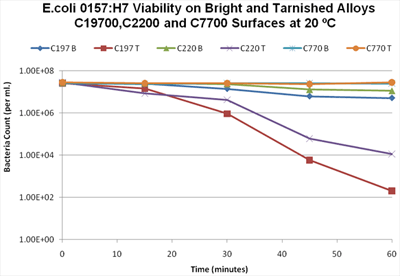The issue of tarnishing is often brought up as it is familiar to all who have observed copper surfaces. Escherichia coli O157:H7 was exposed to several copper alloys in a tarnished and untarnished state to determine whether tarnishing has an impact on the antimicrobial properties of copper. The results clearly show tarnishing is not an issue. In fact, copper surfaces with an oxide layer (tarnish) actually kill organisms faster than untarnished surfaces. The data below clearly dispels the notion that tarnished copper surfaces will no longer be antimicrobial.
 Note: C197, C220 and C770 are copper alloys. The "B" after the alloy indicates untarnished, and the "T" after the alloy indicates a tarnished surface.
Note: C197, C220 and C770 are copper alloys. The "B" after the alloy indicates untarnished, and the "T" after the alloy indicates a tarnished surface.This program is based upon work supported by the U.S. Army Medical Research and Materiel Command under Contract No. W81XWH-07-C-0054. Any opinions, findings and conclusions or recommendations expressed in this material are those of the author(s) and do not necessarily reflect the views of the U.S. Army Medical Research Acquisition Activity.
